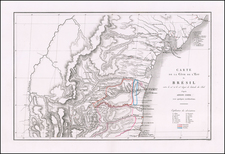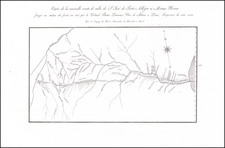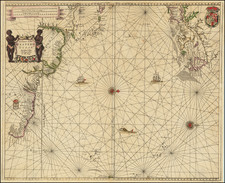Early Manuscript Plan of Rio de Janeiro Dating to the Transfer of the Portuguese Crown to Brazil
Fine manuscript plan of Rio de Janeiro at the beginning of its expansion in the early nineteenth century, almost certainly pre-dating the first printed city plan of Rio de Janeiro.
The map dates to the period when the Portuguese Crown, fleeing Napoleon’s armies, transferred its seat to Rio de Janeiro, making it the capital of the Portuguese Empire. The present map was likely prepared shortly after the arrival of the Portuguese Crown and court, at a time when the initial city planning was being done in anticipation of the growth which resulted from the re-location of the Portuguese capital from Lisbon to Rio.
The plan shows a highly detailed plan of the city, which is beginning to extend away from the harbor. Oriented to the west, the plan shows the Fortaleza Ilha das Cobras, protecting the city from the sea. Several buildings are marked with crosses, indicating the many churches in the Catholic city.
While the details are inked, a pencil grid is visible beneath, revealing the method of construction of the plan: it was drawn square by square. Additionally, there are numbers and letters on some buildings, indicating that originally this map was intended to be accompanied by a key. A decorative compass rose is also pencilled in in the harbor.
Based on the palaeography and comparison with a contemporary map from 1812, the first published plan of Rio and the first to be printed in Rio, this plan directly precedes that map. The 1812 example was printed at the behest of the Portuguese Crown upon their arrival in the city in 1808 but was not completed for four years. As the transfer of the Crown spurred massive and rapid construction in the city, the resemble of this plan with the slightly newer one suggests that the present plan dates to the period of the Crown arriving in Rio from Lisbon.
The Transfer of the Portuguese Crown
The transfer of the Portuguese Royal Court from Lisbon to Rio was a major event for the Portuguese empire and for the city of Rio. In 1807, Napoleon’s forces invaded Portugal because Portugal had allied themselves with France’s great enemy, Britain. This marked the beginning of the Peninsular War. At the time, Portugal was ruled by João VI, prince regent on behalf of Maria I.
Knowing that his army could not hold against the mighty French troops and their allies, João VI decided on a course unparalleled in European history: he decided to transfer the imperial court from Europe to an overseas colony. On November 29, João VI and the royal family of Braganza set sail across the Atlantic, protected by the British Royal Navy; Rio was their ultimate destination.
The royal family and their huge entourage of 15,000 nobleman, civil servants and their families arrived in Rio on March 7, 1808. The presence of the Court transformed Brazil from periphery to metropole. João VI decreed that Brazil’s ports could now trade openly, rather than just with Portugal as had been the case under the mercantile system. Additionally, Brazil was now allowed to develop its own manufacturing industries; previously the colony had only been allowed to act as an agricultural producer.
Their arrival also revolutionized the city of Rio. Although the city had been Brazil’s capital and principal port since 1763, it had been in an economic slump for decades. In 1808, when the Court arrived and around the time this plan was drawn, the population of the city was ca. 85,000. Between 1808 and 1816, over 6,000 new houses were built in the city and 100 new country estates were established in its environs. By 1821, the city's population had grown to 113,000, making it the largest city in South America.
The arrival of the Portuguese Court not only significantly added to the city's population, but also brought great wealth and intellectual sophistication to Rio. This led to the genesis of several institutions, many of which are anchors of Rio and Brazil's economic and cultural life to this day. These included Brazil's first printing house, the Academy of Fine Arts, the botanical gardens, the Rio School of Medicine, the National Library of Brazil and the Bank of Brazil. Within a few years of the Court’s arrival, Rio had transformed into a modern metropolis.
This plan was drawn at the beginning of these changes, just as the city was beginning to expand. It is from a crucial moment in Brazil’s history and deserves a special place in any collection of Brazilian or Portuguese maps.









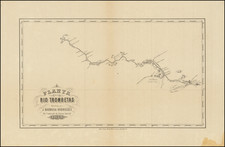
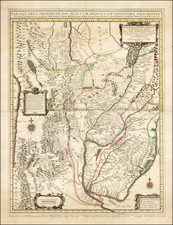
![[ Peru, Ecuador and the Upper Amazon ] Maragnony sive Amazonum Fluminis Terrarum in Orbe Maximi quo ad Hispanicae Potestai subest Cursus cum Fluvys et Regionibus finitimis Utilitati Publicae probatissimis e Documentis accuratus novissime descriptus a quodam pereas provincias olim S.I. Missinario delineatus a Petro Parcar 1785](https://storage.googleapis.com/raremaps/img/small/89253.jpg)
